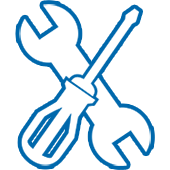You've put a lot of love into your home. It's time to let it give you a little back.
Let your home's equity fund your dream project - whether you want to remodel your kitchen, pay for college, consolidate your debit or take that once in a lifetime vacation. We have options to help you fund it.
Home Equity Lines with a Variable Introductory Rate as low as
8.00% APR* for 12 months
Prime minus 0.50%
|
Current Variable Rate after Introductory Period
8.25% APR*
Prime minus 0.25%
|
| The Variable APRs stated above are current as of 8/1/2023 but can change periodically based on Prime. See below for important additional information. |
*The Variable Introductory Rate is based upon The Wall Street Journal Prime Rate (“Prime”) (8.50% on 8/1/2023) minus 0.50%. Prime may change at any time without notice. If Prime increases or decreases during the Introductory Period, the Introductory Rate and minimum required payment will correspondingly change. The Variable Introductory Rate reflects a rate discount of Prime minus 0.50% for customers enrolled in Direct Rewards Checking, High Interest Checking, or Emerald Checking with automatic payment at the time the Home Equity Line of Credit (HELOC) is opened. The Variable Rate Introductory Offer is applicable to all funds withdrawn from the line of credit during the 12 month Introductory Period beginning from the date the HELOC is opened. After the Variable Rate Introductory Period ends, any and all remaining balances will automatically convert to the Variable Rate of Prime minus 0.25%, if a Direct Rewards Checking, High Interest Checking, or Emerald Checking account with automatic payment is maintained. If Prime increases or decreases, the Variable Rate and minimum required payment will correspondingly change. Other APRs apply without a Direct Rewards Checking, High Interest Checking, or Emerald Checking account with automatic payment. APRs are variable and may change monthly, based upon the Prime rate as published in The Wall Street Journal (8.50% on 8/1/2023), but will not exceed 15.00%. Offer is available on first and second liens with a maximum CLTV of 90% on single-family, owner-occupied residences. HELOC is a 10-year open-end draw line with interest-only monthly payments and 15-year fully amortized monthly payments of principal and interest. Offer is subject to credit approval. Property insurance and, if applicable, flood insurance are required. No closing costs for loans up to $250,000. If you cancel/close your line within 3 years you must reimburse the bank for any third party fees (ranging from $553.96 - $2,516.04) at the time of cancellation. Loans over $250,000: borrower is responsible for 1.00% mortgage tax. Consult tax advisor for tax deductibility. Rates, terms and conditions are subject to change without notice. No other discounts will apply. NMLS#463170. Member FDIC. Equal Housing Lender.
{openTab}
You already know that a Home Equity Line of Credit is a convenient way to finance a wide range of needs. It is important to fully understand how this form of credit works. Please take a moment to read and learn more about Home Equity Line of Credit.
What is a Home Equity Line of Credit?
A Home Equity Line of Credit is a form of revolving credit where your home serves as collateral. Many homeowners use a Line of Credit to finance major items such as education or home improvements. The rate is variable, but often lower than credit cards or other financing that is not secured by collateral.
How does a lender determine my credit limit?
First, a lender will focus on a certain percentage of your home’s appraised value and subtract the balance owed on your existing mortgage. Then, they will examine your credit history and ability to repay both principal and interest on the loan by looking at your income, debts, and other financial obligations. This helps the lender determine if you are eligible for credit and, if so, how much.
What is a draw period?
A Solvay Bank HELOC begins with a 10-year draw period. During this time, you can access your Line of Credit with special checks or use our Online Banking to make an internal transfer to your Solvay Bank Checking or Savings Account. You must make a minimum monthly payment to cover the interest on the credit used. You can also choose to pay principal on your Line of Credit during this time, but it is not required. When your draw period ends, you will no longer have access to your Line of Credit.
What is the repayment period?
The repayment period immediately follows the draw period. During this 15-year period, you must begin paying back the principal balance of your borrowed funds along with interest. Your minimum monthly payments will likely increase during this time as you are paying both principal and interest. The payment can also fluctuate based on your rate, which is variable and subject to change without notice.
Will the rate on my Home Equity Line of Credit change?
A Home Equity Line of Credit has a variable rate based on a publicly available index. Solvay Bank uses Prime as published in The Wall Street Journal. Your rate and minimum monthly payment will change as Prime increases and decreases.
How often will my rate change?
Prime can change at any time without notice. Economic conditions play a key role in determining how often it does or does not change. If Prime does change, your new variable rate would take effect on the 1st of the month following the change.
How will I be notified if my rate changes?
Solvay Bank does not control The Wall Street Journal Prime and has no way of knowing if and when it may change. Your current variable rate is always included in your monthly statement.
What is an Introductory Rate?
Many banks offer an Introductory Rate, which is a temporarily discounted rate for a certain period of time. It is also variable and may fluctuate during the Introductory Period. If your loan qualifies for an Introductory Rate, certain terms and conditions may apply. Be sure to read the disclosures associated with your HELOC.
When does my Introductory Rate end? How does that impact my rate and payment?
If you qualify, an Introductory Rate Period at Solvay Bank is 12 months long and begins the day you open your account, even if you do not use your Line of Credit during that time. After your Introductory Rate Period ends, all remaining balances automatically convert to the Current Variable Rate for a Solvay Bank Home Equity Line of Credit. Your payments in the After Introductory Period will also fluctuate based on Prime.
If I don’t use my Line of Credit, does my rate stay the same?
Your rate is always variable, even if you are not using your Line of Credit. If there is an outstanding balance on your loan, you are still required to make the minimum monthly payment to keep your account in good standing.
How can I get a discount on a Solvay Bank Home Equity Line of Credit?
In order to receive a discount on your variable rates in the Introductory Period and After Introductory Period, you must maintainone of the following with automatic payments: Direct Rewards Checking Account, High Interest Checking Account, or Emerald Checking Accounts. All rates and offers are subject to credit approval, even with a checking relationship.
How do I make an automatic payment?
Payments automatically withdraw from your Direct Rewards Checking Account, High Interest Checking Account, or Emerald Checking Account on the 10th of every month. You do not need to take any action in order to make this payment when enrolled in automatic payments.
What if I do not have an Solvay Bank Checking Account that is eligible for a loan discount?
Your variable rate will not be discounted if you do not have a checking relationship with Solvay Bank or do not wish to open a checking account with us. All rates and offers are still subject to credit approval.
For more details about your rates, and other important information, please read the disclosure associated with your Home Equity Line of Credit.
 Home Improvement
Home Improvement
 College
College
 Debt Consolidation
Debt Consolidation
 Vacation
Vacation

